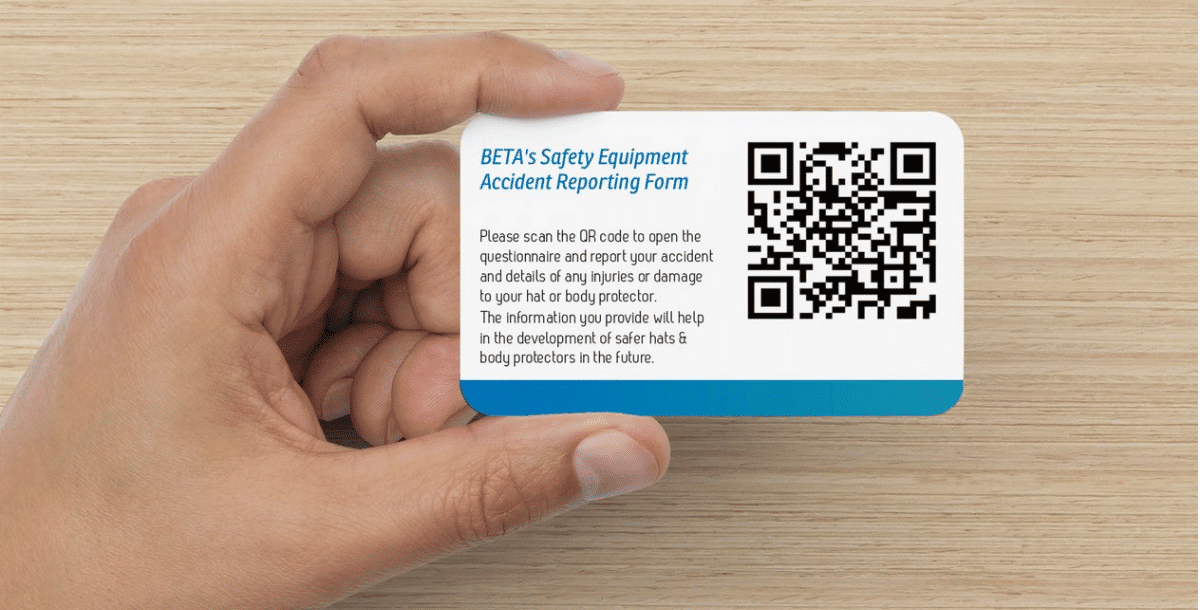Helite is proud to announce a partnership with the Cauda Equina Champions charity, a humble charity with a focus on raising awareness about cauda equina syndrome and reducing the potential trauma, impact, and isolation following a diagnosis. From today moving forward, customers will have an option to add a donation amount of their choice to any purchase of Helite products. This is entirely optional and all additional funds will go straight towards the charity to support their endeavours and projects.
But what exactly is cauda equina syndrome?
“I have been left with permanent numbness in my right leg and foot, and no bladder and bowel function. I am now waiting for my colostomy bag which should be done in the next few months.” explains Jennie Sharpe, owner of JK Equestrian. “I suffered a life-changing injury and was diagnosed with cauda equina syndrome. I had major emergency spinal surgery, my L5/S1 collapsed and crushed my nerve Canal, leaving me with permanent damage and a new disability I had to come to terms with, I was told I’d never walk again unaided and definitely wouldn’t be able to ride again. I proved the surgeons wrong, but had a second case of CES last July (2021) and had emergency surgery again, however they knicked my spinal fluid sac, which meant I was then rushed back in for more emergency surgery. Again I was told it was highly unlikely that I’d ride again. However, I proved everyone wrong again and I’ll never give up on my dream of continuing to jump my horses internationally. I know that my riding career will be over earlier than I would hope for, but for now I have to focus on the positives and continue to prove everyone wrong.
Jennie Sharpe is just one of many patients in the UK that have been affected with cauda equina syndrome, a condition that has affected many equestrians around the world and can often be overlooked as mere saddle numbness. Unfortunately, the tingling and numb sensation that one feels in the saddle region could be a sign of cauda equina syndrome.
What is cauda equina syndrome?
Cauda equina is the name given to the collection of nerves at the end of the spinal cord. This is because it somewhat resembles a horse’s tail, hence the namesake. There are about 10 pairs of nerve roots in the cauda equina and they combine to form larger nerves around the lower body such as the sciatic nerve. If these nerves are damaged or inflamed, then it may cause severe symptoms that develop quickly.
If someone experiences damage to these nerve roots, then it’s imperative that they seek medical attention immediately or else they may face permanent paralysis, bladder and bowel problems, and potential loss of sexual sensation. Even with treatment, people that have cauda equina syndrome might not make a full recovery.
Causes of cauda equina syndrome
It is believed that cauda equina syndrome is mainly caused by a herniated disk, but it can also be the result of a tumour, infection, or narrowing of the spinal canal. The condition is more likely to occur in adults, but can potentially affect children as well, especially if they have a spinal birth defect. Complications from a lumbar spine injury, such as a car crash, fall, or even physical attack, could also lead to cauda equina syndrome.
Symptoms of cauda equina syndrome
Cauda equina syndrome can be hard to diagnose due to the variety of symptoms of the different degrees of severity. It’s also possible for the symptoms of cauda equina syndrome to be similar to other conditions such as back pain. As a result, it can be hard to truly identify if someone is facing cauda equina syndrome or something less concerning.
The main symptoms to look out for are as follows:
- Severe lower back pain
- Numbness in one or both legs
- Pain or weakness in the legs that makes it difficult to walk
- A change in sensations in your legs
- A recent bladder or bowel infection
- Difficulty holding in your urine
- Sudden sexual dysfunction
Since some of these symptoms aren’t exclusive to cauda equina syndrome, it can often be difficult to truly diagnose this condition. However, it’s better to be safe than sorry and to contact your doctor if you believe you may have cauda equina syndrome.
How is cauda equina syndrome diagnosed?
Doctors typically diagnose cauda equina syndrome through a number of tests while also taking your medical history into consideration.
For starters, doctors will ask you a series of questions about your health and activity. They’ll then ask what symptoms you experience and attempt to compare the two to find out if you’re likely to have cauda equina syndrome based on lifestyle choices. If the doctor has reason to believe that you may have the condition, then they’ll move forward with a physical examination. This will test your reflexes, sensation, balance, alignment, motion, and other similar abilities. You may also be asked to take a blood test.
A magnetic resonance imaging (MRI) scan may also be used to further examine your body. This creates 3D images of your spine so that doctors can see if there is any damage that could be the cause of your symptoms. A myelogram, an x-ray of the spinal cord after infection of a contrast material, can also be used to see areas of the spinal cord and nerves that are being subjected to excessive pressure. Lastly, a computed tomography (CT) scan can also be used to diagnose this condition.
How is cauda equina syndrome treated?
The most common way to treat cauda equina syndrome is to quickly relieve pressure on the nerves. This does involve surgery and has to be done quickly to avoid permanently damaging the nerves. If left untreated, it could lead to paralysis of the legs, loss of bladder and bowel control, and other pressing issues that can hinder your lifestyle. The optimal time frame is within 48 hours of the onset symptoms, but it can depend on the cause of your cauda equina syndrome and what symptoms you face.
Depending on how severe your symptoms are, you may need high doses of corticosteroids to reduce swelling during the surgery. If there is an infection, then you’ll also need to take antibiotics. If doctors diagnose your cauda equina syndrome and discover that it’s due to a tumour, then you may need radiation or chemotherapy after the surgery in order to remove it.
Can cauda equina syndrome be fully treated?
Doctors will do their best to treat patients with cauda equina syndrome, but you may not return back to having full function of your body. For example, if the condition is caught too late, then you may continue having bladder and bowel problems for several years. While long-term treatment is possible, it can lead to some difficulties which patients will need to live with due to permanent damage to the cauda equina.
Is cauda equina syndrome a chronic condition?
Cauda equina syndrome is a chronic condition only if permanent damage has occurred. Surgery can help repair it but isn’t always successful due to how quickly the symptoms can develop. If your cauda equina syndrome becomes chronic, then it will require some lifestyle changes in order for you to adapt to how your body functions. As a result, you’ll need both emotional and physical support to help you out.
This is why the Cauda Equina Champions charity was formed.
We briefly introduced Jennie at the beginning of this article and told her story with cauda equina syndrome. As a patient of this condition, Jennie knows full well the emotional and physical distress that cauda equina syndrome can cause.
“I completely lost my nerve and thought my career was over due to my CES being a chronic case,” explains Jennie. As cauda equina syndrome can affect many equestrians around the world, it’s very common for them to be concerned that it will effectively end their career. However, Jennie received support from her peers and with assistance from the Cauda Equina Champions charity.
“With a fantastic support team around me and sheer determination I got back on board and I am back competing! Life is hard, I’m a firm believer in being kind, working hard and supporting everyone, no matter what level they may be.”


What is the Cauda Equina Champions charity?
The Cauda Equina Champions charity offers a range of bespoke and tailor-made services for people who have been diagnosed with cauda equina syndrome and are permanently affected by its symptoms. Even with treatment, it may be necessary for patients to receive ongoing emotional and physical support to help them adapt to their new lifestyle and live their best life.
The charity’s vision is to bring cauda equina syndrome to the forefront of people’s minds. This helps to ensure the condition is taken seriously and for the symptoms to be more well-known. With more awareness comes faster detection of cauda equina syndrome, and this will result in more cases where people can make a faster recovery. We want cauda equina syndrome to become a household name so that everyone, including healthcare professionals, is aware of the red flags that can likely point to the condition.
Who are the Cauda Equina Champions?
The Cauda Equina Champions charity is a patient-led organisation that wants to raise awareness around cauda equina syndrome. It was initially founded as a non-profit organisation by Claire Thornber in 2013. Claire faced cauda equina syndrome and was discharged from the hospital with little help with rehabilitation. She was determined to find the right level of support and care, so she fought to have follow-up appointments and additional services from the NHS.
During this ordeal, Claire discovered that she wasn’t alone.
She joined a Facebook group of cauda equina syndrome patients that experienced the same things. They were lost, scared, and frustrated at the lack of information and care that was afforded to them. It felt like nobody had any advice, and few people seemed to care that they were suffering from such a difficult condition.
As a result, Claire set up a dedicated Facebook support group and shared all of the information that she had gathered during her experiences. With the other members of the group, Claire founded the charity and many of its founding members are still volunteering for the charity. The group now consists of 3700 people from around the world and now has dedicated team of staff and volunteers. All of these members provide support to each other, and the charity operates in 18 different locations across the UK.
The charity also has access to healthcare professionals to provide more options for patients. This also helps to raise awareness of the condition and also provides essential training to volunteers who are taking care of patients with cauda equina syndrome.
Although it has been a long road, the Cauda Equina Champions charity and all of its members are proud to be a patient-led charity that has positively changed the outcomes of thousands of people around the world. Helite is thrilled to work with such an impactful charity, and we’re optimistic about building a future where more people are aware of cauda equina syndrome and how our products can help provide peace of mind to those who need it.
Helite’s partnership with the Cauda Equina Champions charity
Helite manufactures a range of equestrian protective clothing such as the Helite Original Airvest and the Helite Zip’in 2 Airbag. These products are designed to give equestrians extra protection when riding. By using these mechanically triggered airbag systems, equestrians can have more peace of mind when riding; if they were to fall or get knocked off their horse, then the system will trigger and inflate the vest to protect their head, neck and spine
We firmly believe that Helite’s products can be an integral part of the rehabilitation that cauda equina syndrome patients go through.
“I chose to wear my Helite because I was stepping up the levels with my younger green horse and I was feeling physically sick at the thought of getting it wrong at that height and falling off,” explains Jennie. During her rehabilitation, she had concerns that her cauda equina syndrome could make it difficult for her to stay on her horse, and that she would further worsen the condition if she was to fall. But determined to continue with her career, Jennie found that Helite’s products could offer her an additional layer of protection and peace of mind. “I chose to give myself some kind of protection if I was to fall. The Helite is perfect for me. It’s lightweight and breathable, you don’t know you have it on! It’s also super smart over your show jacket.”
From today moving forward, Helite will be supporting the Cauda Equina Champions charity with a donation option on every order of Helite products if you want to show your support and raise awareness of cauda equina syndrome.






